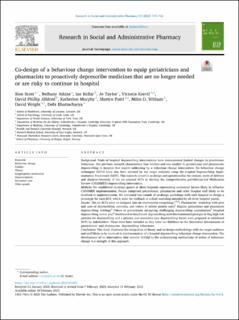| dc.contributor.author | Scott, Sion | |
| dc.contributor.author | Atkins, Bethany | |
| dc.contributor.author | Kellar, Ian | |
| dc.contributor.author | Taylor, Jo | |
| dc.contributor.author | Keevil, Victoria | |
| dc.contributor.author | Alldred, David Phillip | |
| dc.contributor.author | Murphy, Katherine | |
| dc.contributor.author | Patel, Martyn | |
| dc.contributor.author | Witham, Miles D. | |
| dc.contributor.author | Wright, David John | |
| dc.contributor.author | Bhattacharya, Debi | |
| dc.date.accessioned | 2023-05-26T08:53:50Z | |
| dc.date.available | 2023-05-26T08:53:50Z | |
| dc.date.created | 2023-03-14T17:14:52Z | |
| dc.date.issued | 2023 | |
| dc.identifier.issn | 1551-7411 | |
| dc.identifier.uri | https://hdl.handle.net/11250/3069123 | |
| dc.description.abstract | Background: Trials of hospital deprescribing interventions have demonstrated limited changes in practitioner behaviour. Our previous research characterised four barriers and one enabler to geriatricians and pharmacists deprescribing in hospital that require addressing by a behaviour change intervention. Six behaviour change techniques (BCTs) have also been selected by the target audience using the hospital Deprescribing Implementation Framework (hDIF). This research aimed to co-design and operationalise the content, mode of delivery and duration/intensity of the six selected BCTs to develop the CompreHensive geriAtRician-led MEdication Review (CHARMER) deprescribing intervention.
Methods: We established co-design panels at three hospitals representing contextual factors likely to influence CHARMER implementation. Panels comprised geriatricians, pharmacists and other hospital staff likely to be involved in implementation. We convened two rounds of co-design workshops with each hospital to design a prototype for each BCT, which went for feedback at a final workshop attended by all three hospital panels.
Results: The six BCTs were co-designed into an intervention comprising:(1&2) Pharmacists' workshop with pros and cons of deprescribing activities, and videos of salient patient cases3 Regular geriatrician and pharmacist deprescribing briefings4 Videos of geriatricians navigating challenging deprescribing consultations5 Hospital deprescribing action plan6 Dashboard to benchmark deprescribing activitiesAutomated prompts to flag high-risk patients for deprescribing and a primary and secondary care deprescribing forum were proposed as additional BCTs by stakeholders. These were later excluded as they were not fidelitous to the theoretical determinants of geriatricians' and pharmacists’ deprescribing behaviours.
Conclusions: This study illustrates the integration of theory and co-design methodology with the target audience and staff likely to be involved in implementation of a hospital deprescribing behaviour change intervention. The development of an intervention that remains faithful to the underpinning mechanisms of action of behaviour change is a strength of this approach. | en_US |
| dc.language.iso | eng | en_US |
| dc.publisher | Elsevier | en_US |
| dc.rights | Navngivelse 4.0 Internasjonal | * |
| dc.rights.uri | http://creativecommons.org/licenses/by/4.0/deed.no | * |
| dc.title | Co-design of a behaviour change intervention to equip geriatricians and pharmacists to proactively deprescribe medicines that are no longer needed or are risky to continue in hospital | en_US |
| dc.type | Journal article | en_US |
| dc.type | Peer reviewed | en_US |
| dc.description.version | publishedVersion | en_US |
| dc.rights.holder | Copyright 2023 the authors | en_US |
| cristin.ispublished | true | |
| cristin.fulltext | original | |
| cristin.qualitycode | 1 | |
| dc.identifier.doi | 10.1016/j.sapharm.2023.02.003 | |
| dc.identifier.cristin | 2133933 | |
| dc.source.journal | Research in Social and Administrative Pharmacy | en_US |
| dc.source.pagenumber | 707-716 | en_US |
| dc.identifier.citation | Research in Social and Administrative Pharmacy. 2023, 19 (5), 707-716. | en_US |
| dc.source.volume | 19 | en_US |
| dc.source.issue | 5 | en_US |

